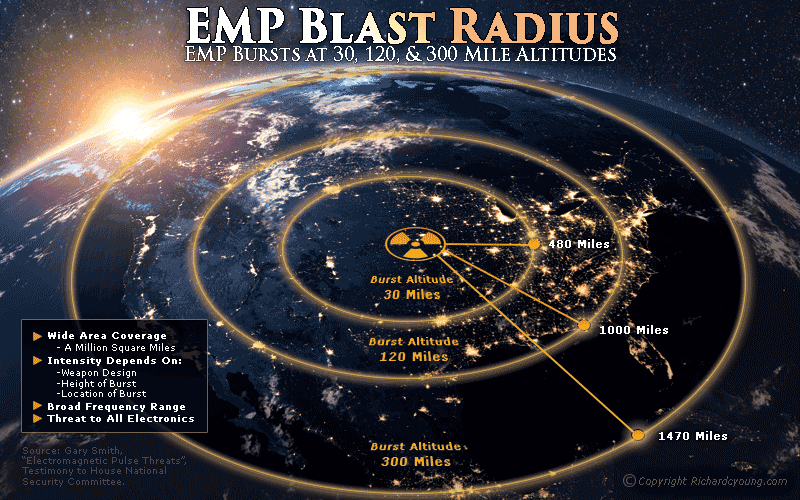Originally posted on January 3, 2009.
While talk of Armageddon may bring to mind tinfoil hats and the funny public service announcements of 1960’s, an electromagnetic pulse (EMP) attack is a real threat. The U.S. government commissioned an exhaustive report on the subject. The scariest scenario is known as a Scud-in-a-Bucket. The scenario goes like this: If a terrorist or rogue state had only a short range missile – a Scud – one could be pulled up to the U.S. in a fishing boat – the bucket – and launched carrying a nuclear payload into the atmosphere above the U.S., causing an EMP. Those simple, readily obtainable technologies can have a profound impact when mixed with nuclear material and hatred.
EMP Checklist:
Water: Your #1 need in any situation is a reliable, substantial supply of clean H2O. I suggest digging a well, having a filtration system , and even storing extra supplies in a barrel.
Heat: It is critical to have a continuous supply of heat to your home. I recommend switching to natural gas if you live in town, and having a wood stove if you can. If you live in coal country, a coal stove or furnace is a great idea. Don’t count on any oil coming down the pipelines any time soon.
Food: A long-term supply of dried bulk foods is a great way to protect yourself from famine. Remember though, if you have “just add water,” type foods, you’ll need to store extra water. The University of Georgia has a great report “Preparing an Emergency Food Supply, Long Term Food Storage“.
Currency: Keep a year’s worth of spending cash on hand. This does not count your checking, savings, brokerage or any other account for that matter. Post-EMP attack, you will likely not have any access to funds cataloged in electronic databases. It is a good idea to also keep some gold and silver coins in small denominations on hand. The coins most likely to be accepted as legal tender are American Eagles.
Information: After an attack, it will be imperative to be tuned in to announcements on where aid is available, possible trouble spots, and other emergency announcements. A radio should be stored in a Faraday box as outlined in the article. Also, to prepare for a return to normal as quickly as possible, think about switching over to a fiber optic network, such as AT&T U-Verse or Verizon FiOs. Those networks may hold up better than traditional cable or wire-line systems.
Electronics: The first step to electronics preparation is the energy itself. Get a generator. Then worry about what you’re running with it. Anything that you find vital (especially medical equipment) should be stored in a Faraday box. Blood sugar monitors might be a good idea for some here. While some electronic devices are critical, you could also put entertainment items in as well (i.e. an electric Fondue pot).
Health: If you are dependent on medicines, try to obtain an extra supply to put away for emergencies. First aid kits are a no-brainer. Don’t forget small things that you may take for granted. That arthritis that comes once in a while might not be so bearable if you don’t have aspirin to combat it.
Sanitation: This goes along with Health and Water, but is important enough to warrant its own category. It’s no fun to talk about sewage, but without power or running water for an extended period of time, sewage will be an issue. Take the time to develop a plan for dealing with waste, not just yours but also garbage from food prep and grey water from washing dishes, etc. Plan to keep even more water on hand to clean yourself and your food.
Fiber Optics
 In the December issue of Intelligence Report, I gave you some information on the threat of an EMP attack on the U.S. and its consequences. I also gave you some ways to prepare. Now I’d like to give you a few more ideas. With an EMP attack critical systems would be down all over the country. Your choices for how you receive heat, fuel, water, and information are important. I advised you to dig a well so you are not reliant on town water, and to switch to natural gas because it would most likely be the first major source of fuel back online. After heat and water are secured, you should think about your ability to communicate. Systems like TV, phone, and the internet would likely be taken away by an EMP. Like energy distribution systems, telecom networks could be out of service for some time. But fiber optic based systems may return to service before copper line counterparts. Copper wires act like antennae, drawing in electromagnetic energy and multiplying the effects of the waves. Fiber optics wires don’t. So while damage would certainly be done to these systems by EMP attack, the extent of damage could be less. Switching to a provider that offers fiber optic service, like AT&T’s U-verse or Verizon’s FiOs, might get your post EMP communications up faster than cable or traditional wire-line phone services.
In the December issue of Intelligence Report, I gave you some information on the threat of an EMP attack on the U.S. and its consequences. I also gave you some ways to prepare. Now I’d like to give you a few more ideas. With an EMP attack critical systems would be down all over the country. Your choices for how you receive heat, fuel, water, and information are important. I advised you to dig a well so you are not reliant on town water, and to switch to natural gas because it would most likely be the first major source of fuel back online. After heat and water are secured, you should think about your ability to communicate. Systems like TV, phone, and the internet would likely be taken away by an EMP. Like energy distribution systems, telecom networks could be out of service for some time. But fiber optic based systems may return to service before copper line counterparts. Copper wires act like antennae, drawing in electromagnetic energy and multiplying the effects of the waves. Fiber optics wires don’t. So while damage would certainly be done to these systems by EMP attack, the extent of damage could be less. Switching to a provider that offers fiber optic service, like AT&T’s U-verse or Verizon’s FiOs, might get your post EMP communications up faster than cable or traditional wire-line phone services.
Faraday Box
To speed along your recovery time, you might keep some cheap electronic replacements stored at your home in a Faraday shielded box. “Faraday shielded,” is a fancy way of saying wrapped in metal, with an insulated core. To make a post-EMP attack electronics kit, simply place a cheap telephone, television, radio, and even a computer, in a cardboard box. Then wrap the cardboard box in aluminum foil. Voila, you are ready for Armageddon. The aluminum foil disperses the EMP field and the cardboard box insulates your electronics from the waves. You can also throw in your favorite video games, a prepaid cell phone, a fondue pot and any other electronic device you may want after an EMP attack. Those of you reliant on medical equipment, such as blood sugar monitors, may want to keep spare parts or units in a Faraday box.
If you’re willing to fight for Main Street America, click here to sign up for my free weekly email.






